« Prince Albert and green blood | Main | Waves, surge, sharks and night dives »
August 26, 2008
Contemplations on a day off
There's much joking going on about "Montezuma's Revenge," the type of gastro-intestinal distress that can afflict travelers who are not used to Central American foods and microbiology. No one expects to become afflicted with it, but three days into the trip I woke up feeling not so well. I had been careful with eating and drinking but apparently not careful enough. 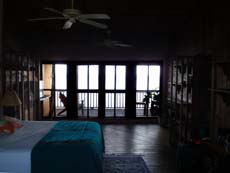 So it was diarrhea and feeling pretty awful. DAN, the Divers Alert Network, has guidelines on what and how to eat and drink in foreign countries, but I must admit I did not brush up on them before we left. I dragged myself to breakfast but did not manage to eat anything. It was obvious I was not up to diving and so I stayed in my room instead. I had seen a black beach towel laying in the water below the cabana that in the shadow looked just like a ray and so I wrote a children's story named "Ray, the ray" where the beach towel became real. I jotted down impressions about the trip. I dozed. I hoped I wouldn't be out of commission for the rest of the week. It'd be awful to have come all the way down to Honduras to experience ocean diving and then be sidelined by diarrhea.
So it was diarrhea and feeling pretty awful. DAN, the Divers Alert Network, has guidelines on what and how to eat and drink in foreign countries, but I must admit I did not brush up on them before we left. I dragged myself to breakfast but did not manage to eat anything. It was obvious I was not up to diving and so I stayed in my room instead. I had seen a black beach towel laying in the water below the cabana that in the shadow looked just like a ray and so I wrote a children's story named "Ray, the ray" where the beach towel became real. I jotted down impressions about the trip. I dozed. I hoped I wouldn't be out of commission for the rest of the week. It'd be awful to have come all the way down to Honduras to experience ocean diving and then be sidelined by diarrhea.
I took some Imodium tablets I'd brought along and wondered about the practical aspects of diving when you don't feel up to par. Boat rides can be pretty rough and sitting in a rocking boat on top of feeling nauseous to begin with didn't sound too good. And I wondered what would happen if you went diving and had to throw up. I'd read about that and apparently you're supposed to vomit through the regulator without taking it out of your mouth. I hoped I wouldn't have to put that to the test. As for diarrhea, the thought of suddenly having an uncontrollable urge while diving with a wetsuit on wasn't pretty.
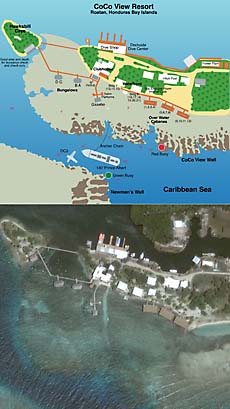 I thought about the amazing CoCo View resort and how it came about. I'd been to Central America in the late 1970s and visited El Salvador and Guatemala. Apparently, while I was lounging by the pool at the luxurious estate of my friends in San Salvador in 1978 and played tennis at the Salvador Sheraton, conditions on Roatan were still quite primitive. Roatan is part of the Honduran Bay Islands that also include Guanaja, Utila and a few dozen much smaller ones. The 49 square mile island was said to be discovered by Columbus on one of his later voyages, then visited by Spanish conquistador Velasquez in an episode disastrous for the indigenous Paya Indians who were enslaved and put to work. Roatan became popular with pirates who, together with the British, were a thorn in the side of the Spaniards. Spain essentially demolished the island by 1650 but English privateers returned and used Roatan as a base. Even the notorious pirate Blackbeard was there for a few weeks in 1718. In the 1700s it was a constant back and forth between England and Spain. By 1800, the English brought thousands of revolting slaves from other islands. Those were called the Garifuna and their descendants are still there today. Roatan was considered a British Crown Colony, albeit a rather minor and neglected one, and influential English families from the Cayman Islands arrived. Though the island was essentially English and Scotch, Queen Victoria, against protests from the settlers, turned Roatan over to an only vaguely interested Honduras in 1858. These days, the official language is Spanish, but many still speak English, and most municipalities have English names.
I thought about the amazing CoCo View resort and how it came about. I'd been to Central America in the late 1970s and visited El Salvador and Guatemala. Apparently, while I was lounging by the pool at the luxurious estate of my friends in San Salvador in 1978 and played tennis at the Salvador Sheraton, conditions on Roatan were still quite primitive. Roatan is part of the Honduran Bay Islands that also include Guanaja, Utila and a few dozen much smaller ones. The 49 square mile island was said to be discovered by Columbus on one of his later voyages, then visited by Spanish conquistador Velasquez in an episode disastrous for the indigenous Paya Indians who were enslaved and put to work. Roatan became popular with pirates who, together with the British, were a thorn in the side of the Spaniards. Spain essentially demolished the island by 1650 but English privateers returned and used Roatan as a base. Even the notorious pirate Blackbeard was there for a few weeks in 1718. In the 1700s it was a constant back and forth between England and Spain. By 1800, the English brought thousands of revolting slaves from other islands. Those were called the Garifuna and their descendants are still there today. Roatan was considered a British Crown Colony, albeit a rather minor and neglected one, and influential English families from the Cayman Islands arrived. Though the island was essentially English and Scotch, Queen Victoria, against protests from the settlers, turned Roatan over to an only vaguely interested Honduras in 1858. These days, the official language is Spanish, but many still speak English, and most municipalities have English names.
A 1996 report by a writer/diver/developer by the name of Lorenzo Dee Belveal who first came to Roatan in 1966, built Spyglass Hill Resort, and ran it until 1981 just when CoCo View got underway is interesting albeit perhaps controversial reading. A most prolific writer, Belveal described the primitive yet pristine condition of the island when he arrived, with spring-clear water and 200-foot visibility, and what he considers the subsequent overpopulation, loss of safe drinking water due to destruction of the natural aquifer and the resulting danger of water-borne disease. In 1995, Belveal's assessment was "It only took fifteen years for it to complete the circuit from "new and exciting" to "ruined and showing it," and his predictions for Roatan's future were dire.
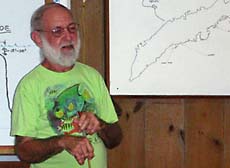 An account penned by Dennis Foster in circa 1990 describes the island as still quite primitive with barely a runway, not much in terms of roads (read Belveal's The Road for an idea), no telephone system and no reliable central electricity. Yet, by that time CoCo View resort had already existed for a decade, established by visionaries Bill and Evelyn Evans with the help of local and immigrated authorities. The "Prince Albert," for example, was named after Albert Jackson, a local tycoon and entrepreneur who built Fantasy Island across the lagoon from CoCo View in 1989 (view the Sinking of the Prince Albert). Another influential persona, "Doc" Radawski, is a fountain of historical knowledge and now resides at CoCo View. He came to Roatan in the early 1970s and has been playing a pivotal role in the scuba diving community as well as marine archeology and ecological programs geared towards preserving Roatan's natural beauty. I greatly enjoyed his excellent lecture on the history of Roatan.
An account penned by Dennis Foster in circa 1990 describes the island as still quite primitive with barely a runway, not much in terms of roads (read Belveal's The Road for an idea), no telephone system and no reliable central electricity. Yet, by that time CoCo View resort had already existed for a decade, established by visionaries Bill and Evelyn Evans with the help of local and immigrated authorities. The "Prince Albert," for example, was named after Albert Jackson, a local tycoon and entrepreneur who built Fantasy Island across the lagoon from CoCo View in 1989 (view the Sinking of the Prince Albert). Another influential persona, "Doc" Radawski, is a fountain of historical knowledge and now resides at CoCo View. He came to Roatan in the early 1970s and has been playing a pivotal role in the scuba diving community as well as marine archeology and ecological programs geared towards preserving Roatan's natural beauty. I greatly enjoyed his excellent lecture on the history of Roatan.
Fortunately and amazingly, in the afternoon I felt well enough to go diving. I found that I had missed some minor discord on the boat that occurred when a guest who was reviewing the resort for a publication or website requested four full boat dives a day as opposed to two dive site dives and two drop-offs. Drop-offs mean the boat won't take you back to the dock and you have to exit through the beach. At CoCo View that's a long swim in very shallow water, and no fun with extensive camera equipment. So the boat took him to some other dive site and thus was not at the dock when the drop-off divers arrived. Some had left personal belongings on the boat including, in one case, their room keys. That, admittedly, can be annoying and so there were complaints. Divemaster Eddie may have gotten an earful from management over that and was none too happy about it. So he called the group together and discussed the matter in a mature and straightforward manner. This young man will go far.
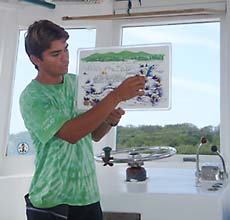 I later got to talk to Eddie whose blond-streaked hair, very much unlike mine, always looked perfectly towsled and coiffed minutes after a dive. His family came from mainland Honduras when he was three years old. They now own some real estate and a store. Eddie has been working in one capacity or another at CoCo View resort since he was in his early teens. He was a busboy, worked in the kitchen, the dive shop, etc., until he got a chance to get into diving. He started highschool, but still has to finish it. He took a course in English, and his mastery of the language is excellent. He fluently converses in English with an accent hardly thicker than mine. English, Eddie said, is necessary on the island to get a good job. That and computer knowledge. No one else in his family speaks English, and Eddie is trying to get at least his sister to learn it. He's never been to the United States but he has a dream of going to college and study something that relates to his love of diving and the sea. Marine biology perhaps. I hope he gets to realize that dream.
I later got to talk to Eddie whose blond-streaked hair, very much unlike mine, always looked perfectly towsled and coiffed minutes after a dive. His family came from mainland Honduras when he was three years old. They now own some real estate and a store. Eddie has been working in one capacity or another at CoCo View resort since he was in his early teens. He was a busboy, worked in the kitchen, the dive shop, etc., until he got a chance to get into diving. He started highschool, but still has to finish it. He took a course in English, and his mastery of the language is excellent. He fluently converses in English with an accent hardly thicker than mine. English, Eddie said, is necessary on the island to get a good job. That and computer knowledge. No one else in his family speaks English, and Eddie is trying to get at least his sister to learn it. He's never been to the United States but he has a dream of going to college and study something that relates to his love of diving and the sea. Marine biology perhaps. I hope he gets to realize that dream.
The dive site we visited was called Menagerhea, named or renamed after Rhea's Diving Services, the diveshop Carol managed for a number of years in Tennessee. The seas were a bit rough but I felt just fine, and even better once I was in the water. The site started out quite shallow, then we slowly descended down along a wall. Looking out into the open blue ocean we saw some pretty big fish, including barracudas and groupers. It's fascinating to gaze into the blueness and suddenly seeing a faint dark shadow that then becomes a fish. You can't quite tell how far away they are, or how big. The Menagerhea site is close to shore by the Newman Wall, and so there was quite a bit of surge.
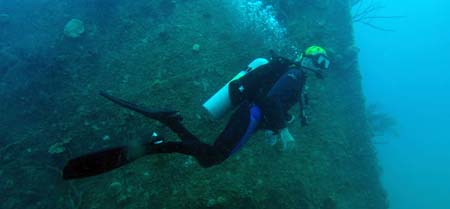
For the drop-off dive I chose the Prince Albert, but this time with a special mission. I took along the Olympus Stylus 1030SW, a 10-megapixel camera that's waterproof to 33 feet without an underwater housing. It's the successor to the Stylus 770SW that we'd taken down to 67 feet at Manatee Springs in Florida with no ill effect. For a while I thought that camera was invulnerable until it did flood at 90 feet in Lake Tahoe when I simply forgot that I'd taken it with me on the dive. I definitely did not want to kill the 1030 as well and so could only take it to the upper parts of the wreck. Still, that meant half an hour between 30 and 40 feet, and a bunch of pretty good pictures -- not bad for a camera that looks just like any other modern little digicam. The visibility wasn't the best, but it took decent pictures.
Posted by conradb212 at August 26, 2008 12:06 AM








